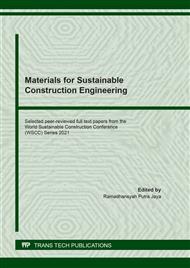[1]
Qin Y, Building Materials, China Construction Industry Press, (2004).
Google Scholar
[2]
Liu J X, Liu P, Zhang M L, Hai R, International advances on physical and mechanical properties of fly ash self-compacting concrete, Concrete, 2020, 11:11-15.
Google Scholar
[3]
Zhang Z G, Zhao L, Zhang P, Zhang R Y, Mechanical properties of engineered cementitious composites with different fly ash contents at sub-elevated temperature, Journal of Southeast University(Natural Science Edition), 2020, 5:831-836.
Google Scholar
[4]
Liu B, Carbonation resistance property of high fly-ash content concrete, Concrete, 2003, 3: 44-48.
Google Scholar
[5]
Zhu Y F, Wang P M, Research on carbonation resistance of concrete containing large amount of fly ash, Journal of Building Materials, 1999, 4:319-323.
Google Scholar
[6]
Wang X, Wang Y B, Yang L S, Zhu X F, Carbonation resistance of high volume fly ash concrete, Concrete, 2013, 2:5-7.
Google Scholar
[7]
Li C H, Niu D T,Song H, Experimental research of carbonization of concrete with composite addition of mineral admixture, Engineering construction, 2009, 6:7-11.
Google Scholar
[8]
Cengiz Duran ATIS, Accelerated carbonation and testing of concrete made with fly ash, Construction and Building Materials, 2003, 17:147-152.
DOI: 10.1016/s0950-0618(02)00116-2
Google Scholar
[9]
Song H, Niu D T, Li C H, Carbonation test of concrete containing mineral admixtures, Journal of the Chinese Ceramic Society, 2009, 12:2066-2070.
Google Scholar
[10]
Khanami, Lynsdale CJ, Strength, permeability and carbonation of high-performance concrete, Cement and Concrete Research, 2002, 32(1): 123–131.
DOI: 10.1016/s0008-8846(01)00641-x
Google Scholar
[11]
Zhang G X, Song J X, Yang J S, Liu X Y, Performance of mortar and concrete made with a fine aggregate of desert sand, Building and Environment, 2006, 41(11): 1478-1481.
DOI: 10.1016/j.buildenv.2005.05.033
Google Scholar
[12]
Liu H F, Ma J R, Chen Y L, Yang D, Mechanical properties of high strength desert sand concrete, Advanced Materials Research, 2015,1095: 263-266.
DOI: 10.4028/www.scientific.net/amr.1095.263
Google Scholar
[13]
Li Z S, Feng D J, Wu S L, A.G.L. Borthwick, J.R. Ni, Grain size and transport characteristics of non-uniform sand in aeolian saltation, Geomorphology, 2008, 100 (9): 484-493.
DOI: 10.1016/j.geomorph.2008.01.016
Google Scholar
[14]
Duan Z H, Xiao H L, Li X R, Dong Z B, Wang G, Evolution of soil properties on stabilized sands in the Tengger desert, China, Geomorphology, 2004, 59: 237-246.
DOI: 10.1016/j.geomorph.2003.07.019
Google Scholar
[15]
Jin B H, Song J X, Liu H F, Engineering characteristics of concrete made of desert sand from Maowusu Sandy Land, Applied Mechanics and Materials, 2012, 174: 604-607.
DOI: 10.4028/www.scientific.net/amm.174-177.604
Google Scholar
[16]
Fu J, Yang D, Liu H F, Ma J R, Influence of fly ash dosage and DSRR on the mechanical properties of desert sand high strength concrete, Science Technology and Engineering, 2015, 9: 230-234.
DOI: 10.1142/9789813200470_0026
Google Scholar
[17]
Liu H F, Liu N, Influence of high temperature on the axis compressive strength and elastic modulus of desert sand concrete, Bulletin of the Chinese Ceramic Society, 2018, 37(11): 166-173 (In Chinese).
Google Scholar
[18]
Liu H F, Chen X L, Che J L, Liu N, Zhang M H, Mechanical performances of concrete produced with desert sand after elevated temperature, International Journal of Concrete Structures and Materials, 2020, https:doi,org/10,1186/ S40068-020-00402-3.
DOI: 10.1186/s40069-020-00402-3
Google Scholar
[19]
Tian S, Liu H F, Song J X, Research on mechanical properties of high strength desert sand concrete after high temperature, Journal of Guangxi University (Natural Science Edition), 2015, 1: 112-120.
Google Scholar
[20]
Liu H F, Ma J R, Wang Y Y, Ning J G, Influence of desert sand on the mechanical properties of concrete subjected to impact loading, Acta Mechanica Solida Sinica, 2017, 30(6): 583-595.
DOI: 10.1016/j.camss.2017.10.007
Google Scholar
[21]
Zhang M H, Liu H F, Sun S, Chen X L, Shu lng Doh, Dynamic mechanical behaviors of desert sand concrete (DSC) after different temperatures, Applied Science, 2019, 9: 4151-4169.
DOI: 10.3390/app9194151
Google Scholar
[22]
Che J L, Wang D, Liu H F, Zhang Y X, Mechanical properties of desert sand-based fiber reinforced concrete (DS-FRC), Applied Science, 2019, 9(9): 1857-1874.
DOI: 10.3390/app9091857
Google Scholar
[23]
Chinese Standard JGJ 52-2006, Standard for technical requirements and test method of sand and crushed stone (or gravel) for ordinary concrete, Beijing: China Architecture and Building Press, 2006 (in Chinese).
Google Scholar
[24]
Chinese Standard GB/T1596-2017, Fly ash used for cement and concrete, Beijing: Standards Press of China, 2017 (in Chinese).
Google Scholar
[25]
Chinese Standard JC/T223-2007, Polycarboxylates high performance water-reducing admixture, Beijing: Standards Press of China, 2007 (in Chinese).
Google Scholar
[26]
China Academy of Building Research, JGJ/T 55-2011 Specification for mix proportion design of ordinary concrete, Beijing: China Architecture and Building Press, (2011).
Google Scholar
[27]
China Academy of Building Research, GB/T 50082-2009 Standard for test methods of long- term performance and durability of ordinary concrete, Beijing: China Architecture and Building Press, (2009).
Google Scholar
[28]
Huang S Y, Modern concrete technology, Xi'an:Shanxi Science and Technology Press, (1998).
Google Scholar
[29]
Sun Y L, Study on effect of carbonation and reinforcementprotection ability of recycled aggregate concrete with watercement ratio, New building materials, 2013, 40( 6):20-22.
Google Scholar
[30]
Zhu Y F, Wang P M, Research on Carbonation Resistance of Concrete Containing Large Amount of Fly Ash, Journal of Building Materials, 1999, 4(5):319-323.
Google Scholar
[31]
Zhu Y P, Yu L, Lv J, Long H B, Effect of fly ash and slag on physico-mechanical property and durability behavior of concrete, Engineering Journal of Wuhan University,2018,51(5):130-134.
Google Scholar
[32]
Mi R J, Pan G H, Research progress in carbonation resistance of recycled aggregate concrete, Journal of Harbin Engineering University, 2020, 41(03):473-480.
Google Scholar
[33]
Wang R X, Mathematical Statistics, Xi'an: Xi'an Jiaotong University Press,(1986).
Google Scholar
[34]
Ru H, Study on evaluation methodology and influencing factors of carbonation of concrete with high content mineral admixture, Beijing: Tsinghua University, (2011).
Google Scholar
[35]
Yang W W, Wang F F, Cui Z Z, Research on the influence of fly ash and magnesium slag on carbonation of C30 concrete, Science Technology and Engineering, 2015, 6:250-253.
Google Scholar


